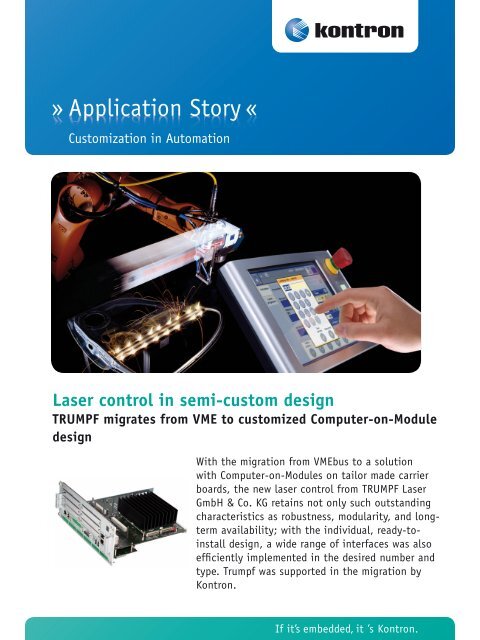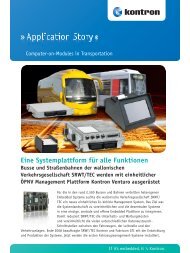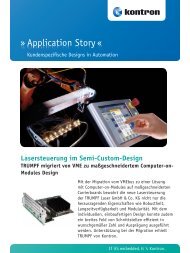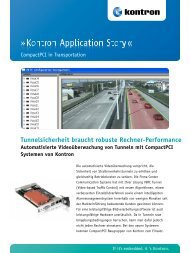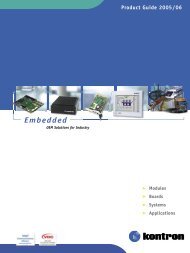About TRUMPF - Kontron
About TRUMPF - Kontron
About TRUMPF - Kontron
You also want an ePaper? Increase the reach of your titles
YUMPU automatically turns print PDFs into web optimized ePapers that Google loves.
» Application Story «<br />
Customization in Automation<br />
Laser control in semi-custom design<br />
<strong>TRUMPF</strong> migrates from VME to customized Computer-on-Module<br />
design<br />
With the migration from VMEbus to a solution<br />
with Computer-on-Modules on tailor made carrier<br />
boards, the new laser control from <strong>TRUMPF</strong> Laser<br />
GmbH & Co. KG retains not only such outstanding<br />
characteristics as robustness, modularity, and longterm<br />
availability; with the individual, ready-toinstall<br />
design, a wide range of interfaces was also<br />
efficiently implemented in the desired number and<br />
type. Trumpf was supported in the migration by<br />
<strong>Kontron</strong>.<br />
If it’s embedded, it ’s <strong>Kontron</strong>.
Lasers prove their worth in tens of thousands of tough<br />
industrial environments. They are contactless in their<br />
operation, do not wear out, and are very flexible: The laser<br />
beams of solid-state lasers, for example, can be set using<br />
a flexible glass fiber from the beam source to the target<br />
location (Figure 1). The requirements for the respective<br />
laser control are high, for it must not only be flexible<br />
in terms of different applications and various connected<br />
peripherals. It must also offer high performance and should<br />
be characterized by longevity and robustness to survive in<br />
the harsh environment of everyday industrial life.<br />
Figure 1: Solid-state laser beams can be coupled into flexible<br />
laser light cables through which they are guided to the target<br />
location.<br />
VME - for many years the best<br />
solution<br />
20 years ago, <strong>TRUMPF</strong> Laser GmbH & Co. KG in Schramberg<br />
began using a modular VME system for control of their solidstate<br />
lasers. The ability of VME to accompany the technical<br />
evolution of the laser control for so long was mainly based<br />
on the advantages of the VME-based architecture: extremely<br />
high ruggedness, long term availability of components,<br />
and a long service life even with increasing performance<br />
demands and increasing levels of integration. In addition,<br />
the VMEbus is technically characterized as an asynchronous<br />
architecture that does not slow down when new hardware<br />
is mixed with old. When more performance was needed, the<br />
CPU module could simply be replaced. This was all offered<br />
with system-specific modularity, so that the upgrade could<br />
easily be carried out with COTS components. VME was,<br />
therefore, a well-rounded solution for long-term product<br />
strategy.<br />
The search for a worthy successor<br />
But times and needs change. For an optimal integration<br />
of solid-state laser control into production networks with<br />
various robots for example, there is still a need for<br />
widespread and individualized interfaces, such as Fieldbus<br />
or Industrial Ethernet interfaces, for sensor and control<br />
circuits. However, many interfaces, which formerly needed to<br />
be integrated with various add-on boards (such as real-time<br />
Ethernet protocol interfaces via EtherCAT) are now available<br />
on the CPU board. As a result, the number of required<br />
add-on cards has dwindled. Furthermore, it has become<br />
increasingly apparent that most peripherals are connected<br />
via USB or Ethernet interfaces, for example, reducing the<br />
number of different interfaces. Therefore, for <strong>TRUMPF</strong>, the<br />
high modularity of VME in the control of solid-state lasers<br />
was no longer necessary. It was important for <strong>TRUMPF</strong>,<br />
however, to maintain the link to the company’s component<br />
bus (<strong>TRUMPF</strong> Peripheral Bus) for signal and data distribution<br />
of components such as lasers, safety equipment, and<br />
cooling. In the past, <strong>TRUMPF</strong> used a separate VME board for<br />
this purpose. Such coupling cards are no longer necessary<br />
due to the advancement of flexibly programmable FPGA<br />
chips over the past few years.<br />
Programmable logic replaces<br />
dedicated hardware<br />
Today, the implementation of the bus mastering for the<br />
component bus is realized by a field programmable gate<br />
array (FPGA) that can be accessed by the CPU via PCI. This<br />
flexibly-programmable device has the advantage that the<br />
control can now communicate directly with the component<br />
bus and actuate the various components through transfer<br />
protocols with optimal performance. Evolutionary changes in<br />
the protocols can simply be implemented by the appropriate<br />
programming of the FPGA logic, ensuring the best possible<br />
future orientation. Thus, the wish list comprised largely<br />
standardized hardware, but with an individually-tailored<br />
interface portfolio and a dedicated interface for the<br />
component bus.<br />
OSADL-Linux support<br />
Application Story<br />
Since the change of its operating system from OS/9 to<br />
Linux, <strong>TRUMPF</strong> wanted the best possible Linux support,<br />
particularly due to its involvement in the industry-driven<br />
real-time operating system OSADL. Because the hardware<br />
supports the operation of OSADL Linux, it is able to reap<br />
the benefits of a broad developer and tool base: shorter<br />
development times, an optimal, well-established integration<br />
of graphical user interfaces, and, therefore, an improved<br />
time-to-market. For <strong>TRUMPF</strong> this had the advantage of<br />
allowing the software development department to focus on<br />
porting from OS/9 to Linux and on the integration of the<br />
human-machine interfaces (HMI) while sparing it the timeconsuming<br />
process of adapting the OSADL operating system<br />
to the embedded hardware platform.<br />
2 www.kontron.com
Finding the optimal solution with<br />
expert help<br />
To find the optimal hardware platform for this list of<br />
requirements and to avoid pitfalls, <strong>TRUMPF</strong> consulted<br />
extensively with experts from the real-time Linux and<br />
embedded hardware fields. It was necessary to ensure an<br />
optimal combination of software and hardware and to find<br />
a scalable long term solution that preserved the benefits of<br />
the incumbent VME Technology. Furthermore, the hardware<br />
platform should offer the advantages of modern computer<br />
technology, such as the cost-effective and comprehensive<br />
integration of current and application-specific interfaces.<br />
In addition to the FPGA, these should include digital inputs<br />
and outputs for applications, lasers, switching stations,<br />
external clock signal generators, stepper motors, etc., that<br />
are addressed directly via digital connections. With these<br />
customization requirements, <strong>TRUMPF</strong> then had the following<br />
options to choose from: the use of motherboards or Single<br />
Board Computers (SBC) with PCI or PC/104 extension cards<br />
for the FPGA and digital I/Os, a CompactPCI design similar<br />
to VME, or an individual board-level solution based on<br />
Computer-on-Modules. The optimal solution for <strong>TRUMPF</strong><br />
ultimately crystallized in a semi-custom design with a<br />
highly integrated Computer-on-Module on an individual<br />
carrier board. Furthermore, the custom front panel design<br />
allows the systems to be removed with similar ease to<br />
systems with a passive backplane.<br />
Individual carrier board design<br />
There were several reasons for <strong>TRUMPF</strong>’s decision to use<br />
a semi-custom design. It has the benefits of a fullycustom<br />
solution but with a faster time to market. The<br />
individually designed carrier boards allow all interfaces,<br />
including Ethernet, Digital I/O, and FPGA coupling to be<br />
implemented exactly in the desired number, specification,<br />
and arrangement of front and rear housing - a convincing<br />
argument against a solution with a standard SBC or<br />
motherboard. Moreover, due to the number of units required,<br />
<strong>TRUMPF</strong> was able to obtain this custom-made solution for<br />
the price of an “off the shelf” system without sacrificing<br />
the proven benefits of the VMEbus. The semi-custom design<br />
also provides the desired long-term availability for industrial<br />
use, necessary ruggedness, and, due to its modular design,<br />
guarantees future security. Thanks to the modular integrated<br />
Computer-on-Modules, the control can grow with future<br />
requirements and innovations by replacing the module, for<br />
example, with a module with greater processing power.<br />
Application Story<br />
Nearly 100% system availability<br />
The high system availability (nearly 100%) of the new<br />
<strong>TRUMPF</strong> laser systems is obtained through the optimal<br />
combination of hardware and software, and also the<br />
built-in remote administration via a VPN connection (or<br />
alternatively, via the modular built-in modem) by the BSIcertified<br />
<strong>TRUMPF</strong> TelePresence portal. Through the secure<br />
remote connection, <strong>TRUMPF</strong> engineers can perform nearly<br />
the same system diagnostics and integration support tasks<br />
as if they were on site.<br />
Should the operating system or the built-in flash memory<br />
cause problems, the system also provides a rescue Linux<br />
located directly in the BIOS module. The rescue system<br />
automatically starts when the integrated flash memory card<br />
fails. When needed, it can also be started manually via the<br />
front panel of the system. Thus, it offers an additional,<br />
higher service instance to which, for example, hardware<br />
diagnostics and repairs - also via remote connection to<br />
the TelePresence Portal - are made possible. Here again,<br />
the design with Computer-on-Modules proves to be more<br />
space-saving and cost-effective than a corresponding VME<br />
solution which would require additional communication and<br />
diagnostic modules for a similar range of services.<br />
On the safe side in the long term<br />
<strong>Kontron</strong>’s design specialists in Kaufbeuren not only<br />
carried out the consulting and design of the system, but<br />
also handled its serial production. “In order to keep the<br />
embedded hardware on the safe side in the long term, a<br />
supplier to be considered as a qualified partner for <strong>TRUMPF</strong><br />
must not only prove control over the technology but also<br />
over the logistics”, says Rainer Thieringer, head of software<br />
development at <strong>TRUMPF</strong>. <strong>Kontron</strong> not only guarantees<br />
availability of spare parts up to 10 years, but the embedded<br />
hardware specialist has, in recent years, already successfully<br />
implemented and mass produced numerous similar layouts.<br />
<strong>Kontron</strong> was the ideal partner for the evolutionary<br />
migration from VME to the new semi-custom design based<br />
on Computer-on-Modules; they provided a compact and<br />
affordable solution that is, at the same time, state-of-theart.<br />
<strong>Kontron</strong>'s commitment to Linux also benefits <strong>TRUMPF</strong>.<br />
For example, <strong>Kontron</strong> offers its own Embedded Linux<br />
distribution, which was created exclusively through the use<br />
of open source modules, and a license may be obtained free<br />
of charge for supported hardware. It is based on the realtime<br />
OSADL Linux kernel and includes a Linux file system,<br />
a cross compiler toolchain, a board driver, libraries for the<br />
<strong>Kontron</strong>-specific hardware features as well as other tools<br />
to download, and an extensive user manual. The extensive<br />
board support packages that <strong>Kontron</strong> provides also unburden<br />
the development departments of clients like <strong>TRUMPF</strong>.<br />
3 www.kontron.com
Conclusion<br />
The change of an embedded system platform often also<br />
means a change of suppliers. However, since <strong>Kontron</strong><br />
boasts the world’s most comprehensive standard product<br />
portfolio and also ensures the highest quality standards<br />
even with individual design services, the migration from<br />
one platformto another is possible at any time. The value of<br />
this is, first, that sales and development are not afraid to<br />
take alternative designs into consideration to find the best<br />
possible approach for each requirement. On the other hand,<br />
standardized enterprise building blocks simplify migration<br />
paths for customers. Finally, the growing know-how between<br />
the customer and supplier is not lost. All these factors<br />
amount to real long-term availability beyond the application<br />
duration, and maximum efficiency in the use of appropriate<br />
embedded computer technology.<br />
The ready-to-install laser control in detail<br />
Application Story<br />
Figure 2: The <strong>TRUMPF</strong> laser control in<br />
<strong>Kontron</strong>’s ready-to-install semi-custom<br />
design.<br />
» Coupling to the customized bus is efficient and future-proof due to the integrated programmable FPGA controller.<br />
» Four real-time Ethernet connections are available for Ethernet-based fieldbus systems and thus are useful for a<br />
growing range of external peripherals.<br />
» 24 digital inputs and outputs are available for applications in which lasers, shared switches, external clock signals,<br />
conventional stepper motors, etc. should be addressed directly via digital connections.<br />
» The secure connection to the <strong>TRUMPF</strong> TelePresence Portal for remote management is available via the modular<br />
modem and through a VPN connection via Ethernet.<br />
» The remote display (8.4", 800x600 pixels) can be placed precisely wherever it is needed: for operation,<br />
programming, diagnostics, configuration, and data recording.<br />
» The OSADL consortium’s real-time Linux operating system is well suited for the high performance requirements of<br />
the laser pulse functions and application development for the open source system is quick and easy.<br />
» The in-BIOS Rescue Linux provides additional control against failures and also allows remote diagnostic and<br />
management procedures.<br />
» The control is extensible for, e.g., Bluetooth or WLAN functionality through the miniPCI slot.<br />
4 www.kontron.com
Figure 3: The new control is used in the <strong>TRUMPF</strong> TruDisk<br />
1000 disk laser, for example.<br />
5<br />
AUThORS<br />
Ingrid Einsiedler<br />
is Marketing Manager at <strong>Kontron</strong> in Kaufbeuren<br />
Richard Stadler is systems engineer at <strong>Kontron</strong> in<br />
Kaufbeuren<br />
Application Story<br />
Figure 4: The semi-custom design with a passively-cooled<br />
Computer-on-Module is also tidy on the inside<br />
Rainer Thieringer<br />
is head of software development at <strong>TRUMPF</strong>.<br />
www.kontron.com
<strong>About</strong> <strong>TRUMPF</strong><br />
<strong>About</strong> <strong>Kontron</strong><br />
<strong>Kontron</strong>, the global leader of embedded computing technology, designs and manufactures<br />
standards-based and custom embedded and communications solutions for OEMs, systems<br />
integrators, and application providers in a variety of markets. <strong>Kontron</strong> engineering and<br />
manufacturing facilities, located throughout Europe, Americas, and Asia-Pacific, work<br />
together with streamlined global sales and support services to help customers reduce their<br />
time-to-market and gain a competitive advantage. <strong>Kontron</strong>’s diverse product portfolio<br />
includes: boards and mezzanines, Computer-on-Modules, HMIs and displays, systems, and<br />
custom capabilities.<br />
<strong>Kontron</strong> is a Premier member of the Intel® Embedded and Communications Alliance.<br />
For half-a-decade now, <strong>Kontron</strong> has been named a VDC Platinum Embedded Board Vendor. Based<br />
entirely on user feedback, industry professionals evaluate vendors on over 45 non-product<br />
related criteria. <strong>Kontron</strong> is only one of two companies to receive the Platinum award 5-years<br />
running.<br />
<strong>Kontron</strong> is listed on the German TecDAX stock exchange under the symbol „KBC“.<br />
For more information, please visit: www.kontron.com<br />
CORPORATE OFFICES<br />
Europe, Middle East & Africa<br />
Oskar-von-Miller-Str. 1<br />
85386 Eching/Munich<br />
Germany<br />
Tel.: +49 (0)8165/ 77 777<br />
Fax: +49 (0)8165/ 77 219<br />
info@kontron.com<br />
6<br />
North America<br />
14118 Stowe Drive<br />
Poway, CA 92064-7147<br />
USA<br />
Tel.: +1 888 294 4558<br />
Fax: +1 858 677 0898<br />
info@us.kontron.com<br />
Asia Pacific<br />
17 Building,Block #1,ABP.<br />
188 Southern West 4th Ring Road<br />
Beijing 100070, P.R.China<br />
Tel.: + 86 10 63751188<br />
Fax: + 86 10 83682438<br />
info@kontron.cn<br />
Application Story<br />
<strong>TRUMPF</strong> is a world market leader in the field of industrial lasers and laser systems technology.<br />
Its diverse service portfolio ranges from feasibility studies in application laboratories<br />
worldwide, to advice on laser construction, up to complete plant design.<br />
www.kontron.com<br />
#Application Stories - Trumpf_neu# 04292010RIM<br />
All data is for information purposes only and not guaranteed for legal purposes. Subject to change without notice. Information in this datasheet has been carefully checked and is<br />
believed to be accurate; however, no responsibility is assumed for inaccurancies. All brand or product names are trademarks or registered trademarks of their respective owners.


